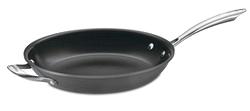
SAFARI
Users
General & Safety
Aluminum is highly reactive. It is rapidly dissolved by acids (many foods) and alkalis (many cleaning preparations). The health impact of aluminum dissolved in food and ingested is the subject of considerable debate. A while ago aluminum was a major suspect in Alzheimers disease, but this view is currently out of favor. In any case, aluminum, a metal, can't be good for the flavor of your food.
Today bare and lightly anodized aluminum cookware appears almost entirely in bakeware and restaurant equipment: stock pots, very large sauté pans and the like - mainly used for non-acidic foods.
On the other hand, while aluminum is toxic, the dosage you are likely to get from aluminum cookware is very small. Way higher dosages come from antacids, antiperspirants, baking soda and some cosmetics.
Aluminum cookware for the home is now pretty much all "hard anodized". This is an acid-electric treatment that builds up a film of extremely hard and non-reactive aluminum oxide, temperature resistant to the melting point of aluminum. This coating may be colored but most anodized cookware is charcoal or black.
This anodized surface is also non-porous, thus quite non-stick, and on basis of the anodizing, this cookware is declared entirely safe, regardless of you opinion of the safety of underlying aluminum itself. Hard Anodized Aluminum is used particularly for skillets, sauté pans and other stovetop cooking applications.
Like all coatings, this coating is vulnerable. It can be broken by scratches. While it is very hard itself, it is supported by a rather soft aluminum metal underlay. It is also eventually dissolved in normal use by the acids and alkalis it is exposed to in cooking and cleaning. When you start seeing silvery patches on your cookware, it's time it was replaced.
Non-Stick Coatings
Non-stick cookware is a very attractive idea, but one that rarely lives up to its promise. Some chefs like to have a non-stick pan for scrambled eggs, but beyond that most do not favor non-stick cookware. Photo at the top is of a Cuisinart skillet, quite suitable for eggs.
The biggest problem with non-stick coatings is fragility. I'm sure better non-stick cookware measures up to the manufacturer's claims in the laboratory, but the kitchen is not a laboratory environment. At best it's an industrial environment, and at worst resembles a combat zone. Tools will be abused, accidents will happen and non-stick cookware is particularly vulnerable.
There are basically two non-stick coatings, though they may go under various names: PTFE (Teflon), and Ceramic.
PTFE Coatings
The first non-stick coating applied to aluminum pans was Polytetrafluoroethylene (PTFE), commonly known as Teflon. It is still in use, and properly applied over a Hard Anodized surface (but may not be in cheaper products). It is, however, easily scraped off. Some better brands use up to 5 layers variously applied to counter this, but even so, experts say to expect no more than 3 years from PTFE coated pans, even if you use wood and plastic utensils.
The other problem with PTFE coatings is temperature. They start to degrade seriously above 450°F/230°C. Above 500°F the toxic fumes are so bad they can kill pet birds. You certainly don't want to use PTFE for applications like stir frying, which regularly exceed 450°F. The wisp of smoke you see from you wok should be oil smoke, not hydrofluoric acid fumes. For this reason, teflon coated wire is not allowed in submarines and aircraft.
Back in 2009, Good Housekeeping had a well referenced article on non-stick cookware. It's gone now, but it included these recommendations.
- Never preheat an empty pan.
- Don't cook on high heat.
- Ventilate your kitchen.
- Don't broil or sear meats.
- Choose a heavier non-stick pan.
- Avoid chipping or damaging a pan.
Ceramic Non-Stick
The more recent Non-Stick coating is variously described as Ceramic and "Eco-Friendly. Some even claims to be "Diamond-Infused" for greater durability. Basically, its made of silica and titanium, and is a form of glass. Like glass it can chip and be destroyed by heat shock. Resistance to heat shock varies by brand.
The biggest advantage of this coating is that it can easily go to 600°F/315°C without degrading or emitting toxic fumes. This is the kind of coating used on the Gotham Steel Electric Grill / Griddle mentioned on this site, and yes, it can chip if abused. It is not recommended to put most ceramic coated cookware in the dishwasher, but to hand clean.
Using the Gotham Steel griddle, I have found claims that you don't need oil to be exaggerated. It works much better with oil, and I expect other ceramic coated aluminum products are similar. Don't worry about that - the Low Fat Diet has been entirely discredited, but some people are still making money off of it.
Links
- 1 - Safety - emedicine - Toxicity, Aluminum.



